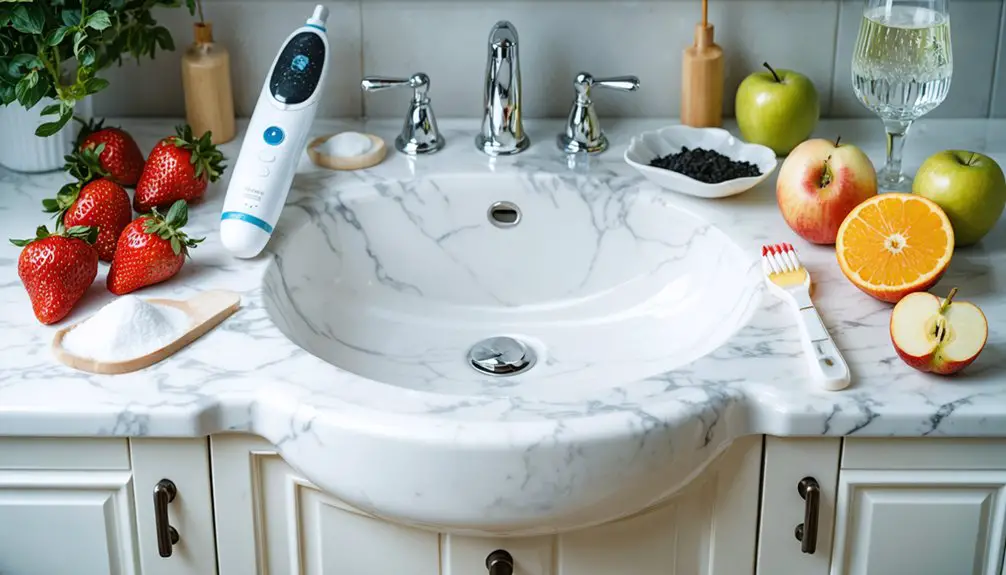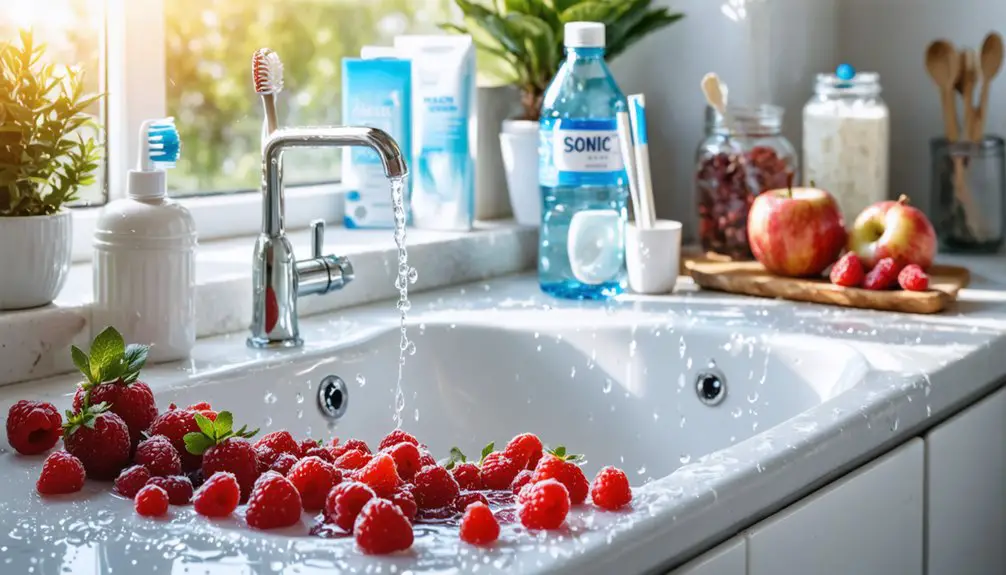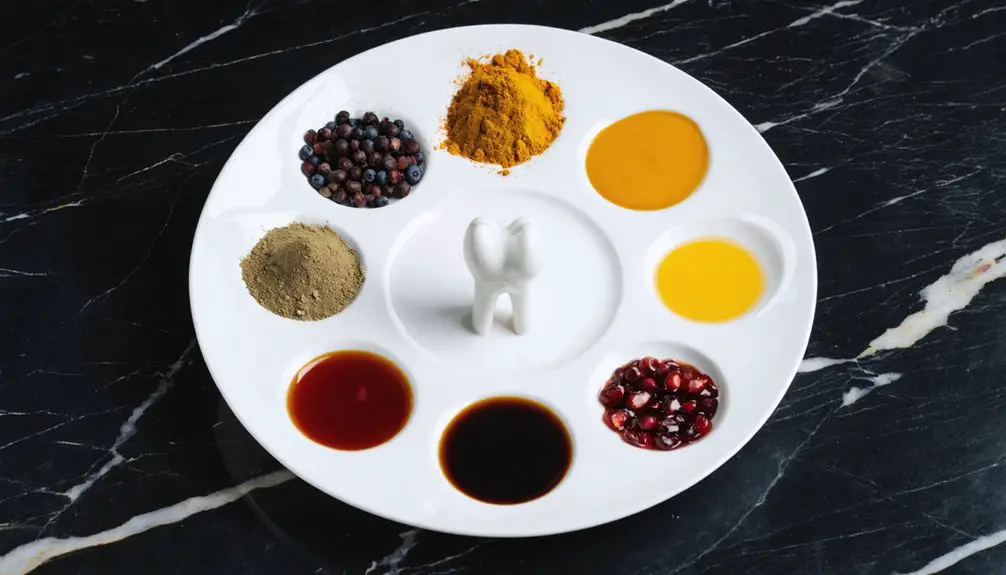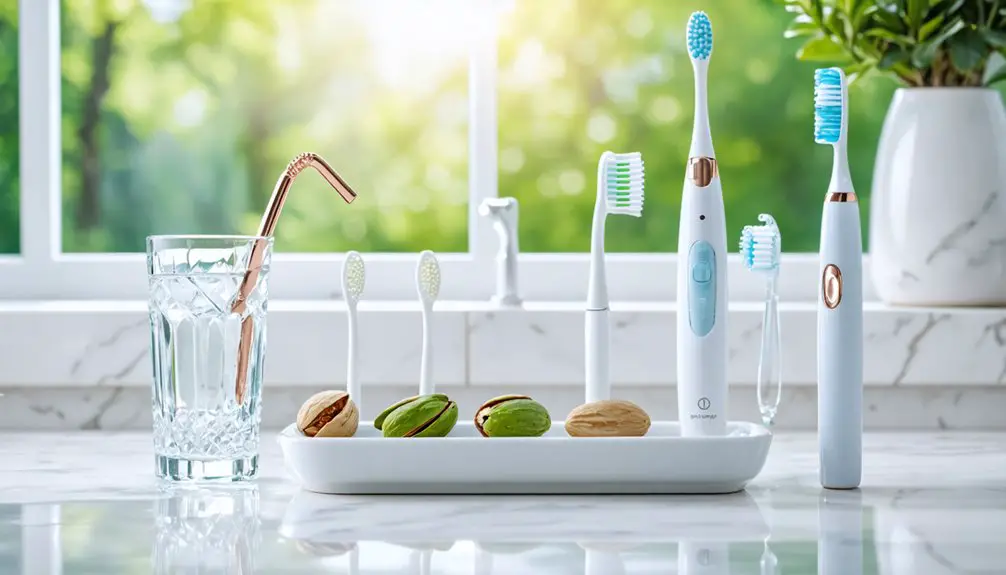To combat teeth yellowing from tannins, you’ll need a multi-pronged approach. Use a straw to minimize contact with your teeth, rinse thoroughly with water after consuming tannin-rich beverages, and wait 30 minutes before brushing. Incorporate whitening toothpaste, regular professional cleanings, and natural remedies like baking soda paste or oil pulling. Combine these with smart timing of beverage consumption and calcium-rich foods to protect your enamel. Understanding the full scope of prevention techniques will strengthen your defense against stubborn stains.
Key Takeaways
- Use a straw positioned towards the back of your mouth when drinking tannin-rich beverages to minimize contact with front teeth.
- Rinse your mouth thoroughly with water immediately after consuming coffee, tea, or wine to flush away staining compounds.
- Schedule tannin-rich drinks during meals when increased saliva production helps neutralize staining effects and protect teeth.
- Brush teeth with whitening toothpaste containing baking soda and hydrogen peroxide to help remove surface stains.
- Maintain regular professional cleanings every six months and use an electric toothbrush for more effective stain removal.
Understanding How Tannins Stain Your Teeth
Have you ever wondered why your morning coffee or evening tea gradually dulls your smile? The answer lies in tannins, powerful polyphenolic compounds found in many common beverages and foods.
When you consume tannin sources like tea, coffee, wine, or dark chocolate, these compounds bind aggressively to your tooth enamel‘s protein layer, called the pellicle. Extrinsic stains can occur when proper oral hygiene habits are neglected.
Your teeth’s natural porosity makes them vulnerable to tannin infiltration, especially when acidic conditions are present. These compounds don’t work alone – they interact with other pigmented molecules (chromogens) to create stubborn stains. Professional teeth whitening can effectively remove these deep-set stains by up to eight shades.
For effective stain prevention, it’s essential to understand that tannins become more problematic with extended exposure. The compounds increase oral biofilm’s stickiness, trapping more pigments against your teeth and deepening discoloration over time.
Smart Drinking Habits to Prevent Staining
You’ll notice dramatic reductions in teeth staining by adopting three key drinking habits: using straws to bypass direct contact with front teeth, timing your consumption to minimize exposure, and rinsing with water between sips.
When drinking stain-prone beverages like coffee, tea, or red wine, position your straw toward the back of your mouth and try to finish your drink within a single sitting rather than sipping throughout the day. Dark chromogens in these beverages can quickly discolor your teeth if left in contact for extended periods.
Make it a habit to swish water in your mouth after each serving of a tannin-rich beverage, as this simple practice helps wash away pigments before they can bond to your enamel. Dark liquors containing high molasses content often leave stubborn stains, so this rinsing technique is especially important when enjoying rum or similar spirits.
Use Straws When Drinking
When it comes to protecting your teeth from staining beverages, using a straw can greatly reduce discoloration and maintain a brighter smile.
You’ll want to position the straw toward the back of your mouth, bypassing your front teeth to minimize contact with chromogens found in coffee, tea, and wine.
For ideal results, select reusable straws made from safe materials and maintain proper straw hygiene through regular cleaning.
While straws effectively reduce staining, they don’t prevent all discoloration, especially on back teeth. You’ll still need to maintain regular brushing, flossing, and professional cleanings.
Complement your straw use by drinking water between beverages and rinsing your mouth afterward. This simple habit can protect your enamel from decay while reducing stains.
Remember that proper straw positioning is essential – incorrect placement can concentrate liquid streams on specific teeth, potentially increasing decay risk.
Those recovering from tooth extractions should avoid straws completely, as the suction can cause painful dry socket complications.
Time Your Beverage Consumption
Smart timing of beverage consumption plays an essential role in preventing tooth discoloration. You’ll greatly reduce staining by scheduling your coffee, tea, or wine intake during meals rather than sipping throughout the day. This meal pairing strategy increases saliva production, which naturally cleanses your teeth of pigments. Red and white wine can significantly contribute to staining through their high tannin content and acidity.
When you do drink staining beverages, consume them quickly instead of prolonged sipping, and follow up immediately with water rinses. Using a straw while drinking can significantly minimize contact between staining liquids and your teeth. Wait 30 minutes before brushing to protect your enamel, as it needs time to reharden after acid exposure.
Your beverage timing should include planned breaks between drinks to maintain neutral oral pH levels. For maximum protection, combine these timing practices with milk additives or water dilution to neutralize tannins and minimize their contact with your teeth.
Rinse After Every Sip
Regular rinsing with water after consuming staining beverages represents one of the most effective defenses against tooth discoloration.
To maximize stain prevention, you’ll want to swirl water in your mouth after each sip of coffee, tea, or other tannin-rich drinks. This technique helps flush away pigments before they can adhere to your enamel’s pores. You can also enjoy your beverage with cheese plates nearby, as cheese creates a protective coating on teeth. Using a soft-bristled toothbrush for your daily cleaning routine will help maintain enamel health while preventing stains.
Don’t wait until you’ve finished your beverage – immediate mouth rinsing is important. You can enhance this practice by keeping water nearby as a companion drink, alternating sips between your beverage and water.
If you’re unable to rinse immediately, chewing sugar-free gum can stimulate saliva flow, providing natural cleansing action.
Remember to avoid brushing right after acidic drinks; instead, rinse thoroughly and wait 30 minutes before mechanical cleaning to protect your enamel.
Essential Daily Oral Care Practices
Your brushing technique directly impacts how effectively you’ll remove surface stains and prevent yellowing, so focus on using gentle circular motions while reaching all tooth surfaces including the often-missed inside areas.
You’ll need to maintain consistent pressure and spend at least two minutes brushing twice daily with fluoride toothpaste to properly eliminate plaque buildup that leads to discoloration.
After meals, you should rinse your mouth thoroughly with water to wash away staining agents and acidic residues before they can settle into your enamel.
Brushing Technique Matters Most
While many people focus on expensive whitening treatments, proper brushing technique serves as the cornerstone of maintaining a bright, stain-free smile.
You’ll need to brush at least twice daily for two minutes each session, using gentle circular motions at a 45-degree angle toward your gum line. Don’t scrub horizontally, as this can damage your enamel and gums.
Position your soft-bristled brush to reach all tooth surfaces – inside, outside, and chewing areas. Pay special attention to the gum line where plaque accumulates, and use the brush tip for hard-to-reach spots behind front teeth and molars.
After consuming staining foods or drinks, wait 30 minutes before brushing to protect your enamel from acid erosion.
Rinse After Every Meal
Implementing an effective post-meal rinsing routine stands as a crucial defense against tooth discoloration.
You’ll want to rinse within 5 minutes after eating, using plain water or non-acidic liquids to flush away staining compounds and food particles that cause yellowing.
Your rinse frequency should align with your meal schedule, ensuring you’re cleansing after each exposure to tannin-rich foods and beverages.
Don’t brush immediately after acidic meals – instead, rinse and wait 30 minutes to protect your enamel. For enhanced protection, consider using milk-based rinses when available, as casein helps bind with tannins and prevent staining.
Complement your post-meal rinsing by using a straw for staining beverages and incorporating crunchy fruits and vegetables to stimulate natural cleansing through increased saliva production.
Natural Remedies for Tannin Stain Removal
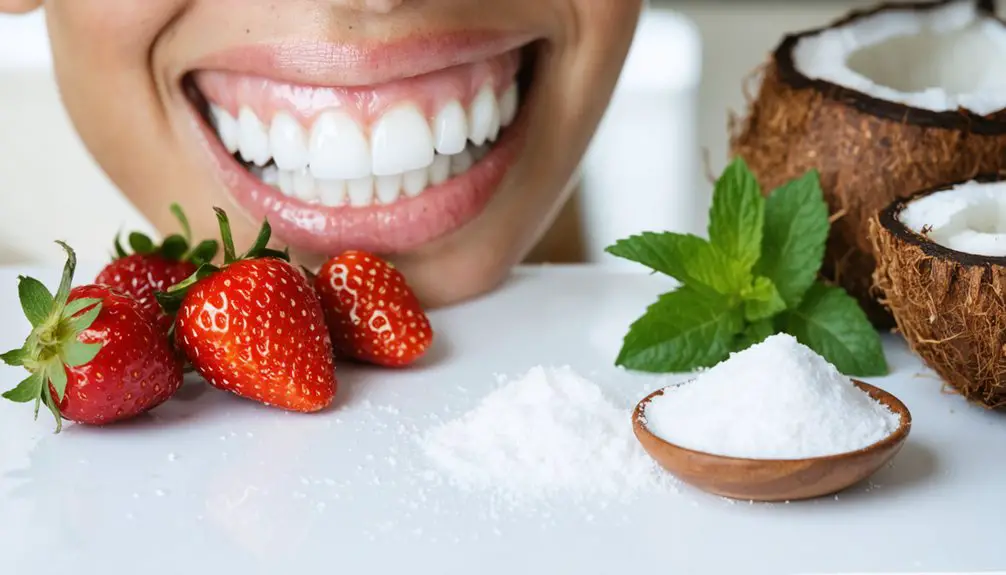
Several natural remedies can effectively combat tannin stains on teeth without resorting to harsh chemicals.
Create a whitening paste by mixing baking soda with hydrogen peroxide, and brush 2-3 times weekly to break down surface stains.
Practice oil pulling with coconut or sesame oil for 15-20 minutes daily before brushing to reduce plaque buildup and prevent new stains.
Oil pulling is a time-tested method that fights tooth stains naturally – just swish oil in your mouth before brushing for healthier, whiter teeth.
For gentle stain removal, harness fruit enzymes by making a paste with mashed strawberries and a pinch of baking soda, using it weekly.
You can also try an apple cider vinegar rinse (one part vinegar to two parts water) once or twice weekly.
Additionally, activated charcoal can absorb surface stains when applied gently with a wet toothbrush.
Remember to use these methods moderately to protect your enamel.
Professional Teeth Whitening Options
Professional teeth whitening options offer remarkably more potent and efficient solutions compared to at-home treatments.
In-office whitening using laser technology can transform your smile in just 60-90 minutes, utilizing high-concentration peroxide gels activated by precision lasers that effectively break down stubborn tannin stains.
LED systems provide another excellent professional option, combining blue light technology with professional-grade whitening agents. You’ll benefit from customizable treatment intensities based on your sensitivity levels, with noticeable results typically achieved in 1-2 sessions.
Both methods use considerably stronger bleaching agents (25-40% hydrogen peroxide) than over-the-counter products, all under careful professional supervision to guarantee safety and ideal results.
Your dentist will first examine your teeth to determine the most suitable approach for your specific staining situation.
Diet Modifications for Whiter Teeth
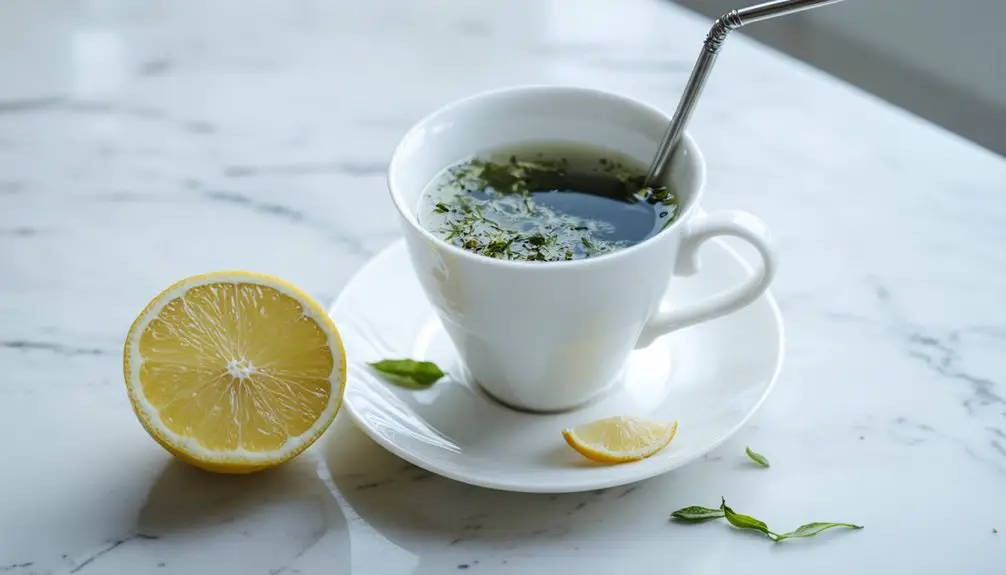
While professional treatments can dramatically improve tooth color, your daily food choices have a lasting impact on maintaining whiter teeth.
Incorporate dietary fibers through crunchy snacks like raw apples, carrots, and celery, which naturally scrub your teeth and stimulate saliva production. Add calcium-rich dairy products, especially cheese and yogurt, to strengthen your enamel and protect against staining.
Make fluoridated water your primary beverage, sipping it frequently throughout the day to wash away pigments and acids. Include natural whitening foods like strawberries, pineapples, and papayas, which contain enzymes that help break down surface stains.
When you consume staining beverages like coffee or red wine, pair them with cheese or water to minimize discoloration. These strategic dietary choices will complement your whitening efforts and promote lasting results.
Protective Measures While Enjoying Tannin-Rich Foods
Enjoying your favorite tannin-rich foods and beverages doesn’t have to come at the expense of your smile’s brightness. To minimize tannin effects, use a straw when drinking beverages like tea or coffee, and avoid swishing these liquids around your mouth.
Sip tannin-rich drinks through a straw and avoid swishing to protect your teeth from staining while still enjoying your favorites.
After consumption, wait 30 minutes before brushing to protect your enamel, but rinse immediately with water to wash away staining compounds.
Maintain diligent oral hygiene by flossing daily and incorporating sugarless gum to stimulate saliva production.
When possible, opt for lighter-colored versions of tannin-rich drinks or add milk to help neutralize staining potential.
Remember to space out your consumption of staining foods and drinks throughout the day, allowing your teeth recovery time between exposures.
Best Products for Combating Tannin Stains
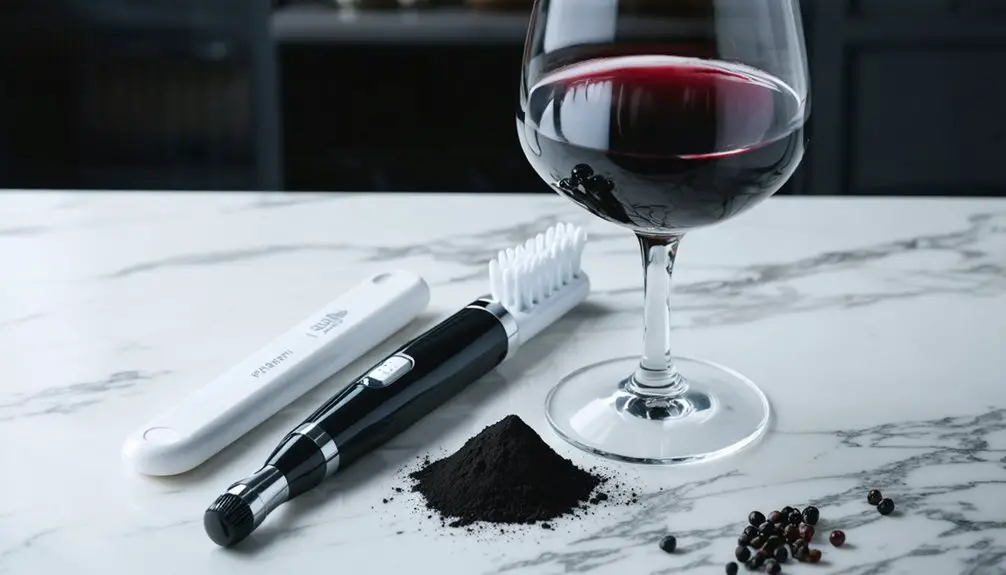
To effectively combat tannin stains, you’ll need to choose from several proven whitening solutions available through dental professionals and over-the-counter products.
Professional treatments using carbamide peroxide gels with custom mouthguards offer the most controlled and lasting results while minimizing sensitivity risks.
For those seeking effective home remedies and whitening tools, consider these validated options:
- Dentist-prescribed at-home whitening kits with custom-fitted trays for precise application
- Over-the-counter whitening strips containing hydrogen peroxide or PAP, used sparingly to protect enamel
- Baking soda and hydrogen peroxide paste applied 2-3 times weekly for gentle stain removal
- Specialized tools like the Tooth Stain Eraser with rubber polishing tips for mechanical stain reduction
Remember to prioritize enamel protection while pursuing your desired whitening results.
Lifestyle Changes to Maintain Teeth Brightness
Since maintaining bright teeth requires more than periodic whitening treatments, implementing strategic lifestyle changes can greatly impact your dental aesthetics. Your daily choices considerably influence tooth color, making lifestyle adjustments essential for lasting results.
Start by modifying your drinking habits – use straws for pigmented beverages and rinse with water immediately after consumption. You’ll want to incorporate crunchy fruits and vegetables into your diet, as they naturally scrub teeth while stimulating saliva production.
Establish consistent dental habits by brushing twice daily with fluoride toothpaste and flossing regularly. Replace staining beverages like coffee and red wine with lighter alternatives when possible.
Additionally, quit smoking and tobacco use, as these considerably contribute to tooth discoloration. Support these changes with regular dental check-ups for professional maintenance.
Long-Term Strategies for Stain Prevention
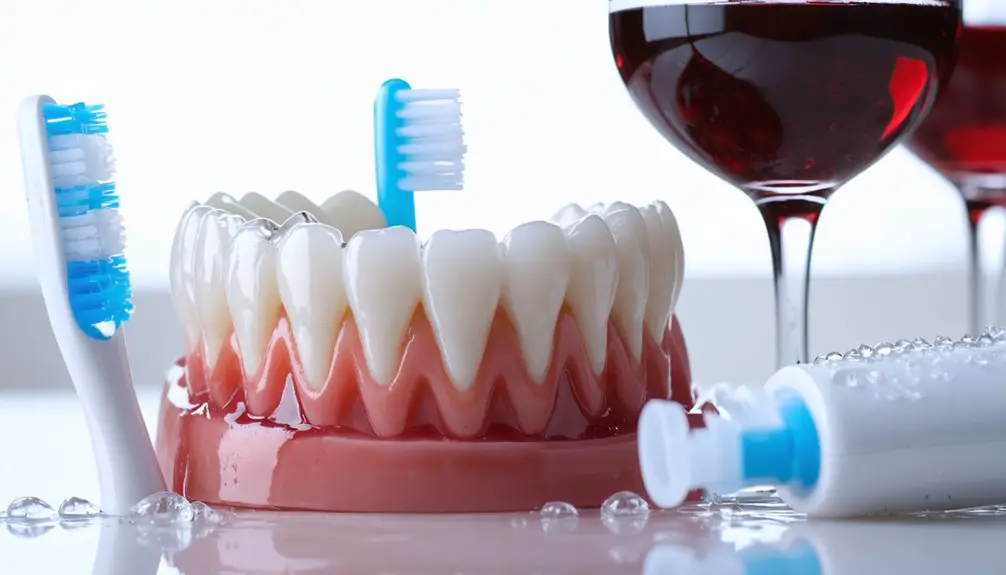
Maintaining bright teeth over the long term requires a thorough approach that combines professional care with daily preventive measures.
A beautiful smile demands dedication – blending expert dental supervision with consistent at-home care for lasting results.
To guarantee effective stain removal and enamel protection, you’ll need to implement consistent strategies that address both prevention and maintenance.
- Schedule regular professional cleanings every six months, as they’re essential for removing deep-set stains and monitoring enamel health.
- Use an electric toothbrush with whitening toothpaste twice daily, focusing on all surfaces for complete stain removal.
- Adopt protective drinking habits by using straws for tannin-rich beverages and rinsing your mouth immediately after consumption.
- Strengthen your enamel through a calcium-rich diet and limited exposure to acidic foods, making your teeth naturally more resistant to staining compounds.
Frequently Asked Questions
Can Genetics Make Some People More Susceptible to Tannin Staining Than Others?
Your genetic predisposition can greatly affect tannin absorption, as inherited traits like thinner enamel, softer tooth structure, or conditions like amelogenesis imperfecta make you more vulnerable to staining.
Does Swimming in Chlorinated Pools Affect How Tannins Stain Teeth?
Yes, chlorine exposure from pools weakens your tooth enamel, making it more susceptible to tannin staining. Poor pool hygiene with high chlorine levels can accelerate this damaging effect considerably.
How Do Medications Interact With Tannin Staining on Teeth?
Like a magnet attracting metal, your medications can intensify tannin staining. You’ll need extra dental care if you’re taking antibiotics, chlorhexidine mouthwash, or saliva-reducing drugs to prevent tooth discoloration.
Can Pregnancy Hormones Increase Tooth Sensitivity to Tannin Staining?
Yes, your hormonal changes during pregnancy can make teeth more susceptible to tannin staining due to increased gum sensitivity and inflammation. You’ll need extra diligent dental care to protect against discoloration.
Do Different Tooth Filling Materials Attract Tannin Stains Differently?
While composite fillings show 60% more tannin discoloration than other materials, you’ll find ceramic filling materials offer superior stain resistance, followed by amalgam, which doesn’t absorb stains but appears metallic.
References
- https://www.dentalhealthandwellnessboston.com/blog/2024/12/12/what-foods-and-drinks-cause-staining/
- https://www.listerine.co.uk/teeth-whitening/yellow-teeth-causes
- https://topellicottcitydentists.com/blog/10-causes-of-yellow-teeth-how-to-treat-them/
- https://pmc.ncbi.nlm.nih.gov/articles/PMC9683888/
- https://www.webmd.com/oral-health/features/foods-stain-teeth-feature
- https://www.jstage.jst.go.jp/article/jarde/20/2/20_jarde20_47/_pdf
- https://www.sldds.com/blog/how-tannins-stain-teeth/
- https://syossetdentalcare.com/2012/12/04/syosset-dentist-tooth-staining/
- https://www.dentalcare.com/en-us/ce-courses/ce491/staining-types-and-causes
- https://lakewooddentalarts.com/p/BLOG-86494-2021.8.23-What-Tannins-Do-That-Stain-the-Teeth-p.asp
